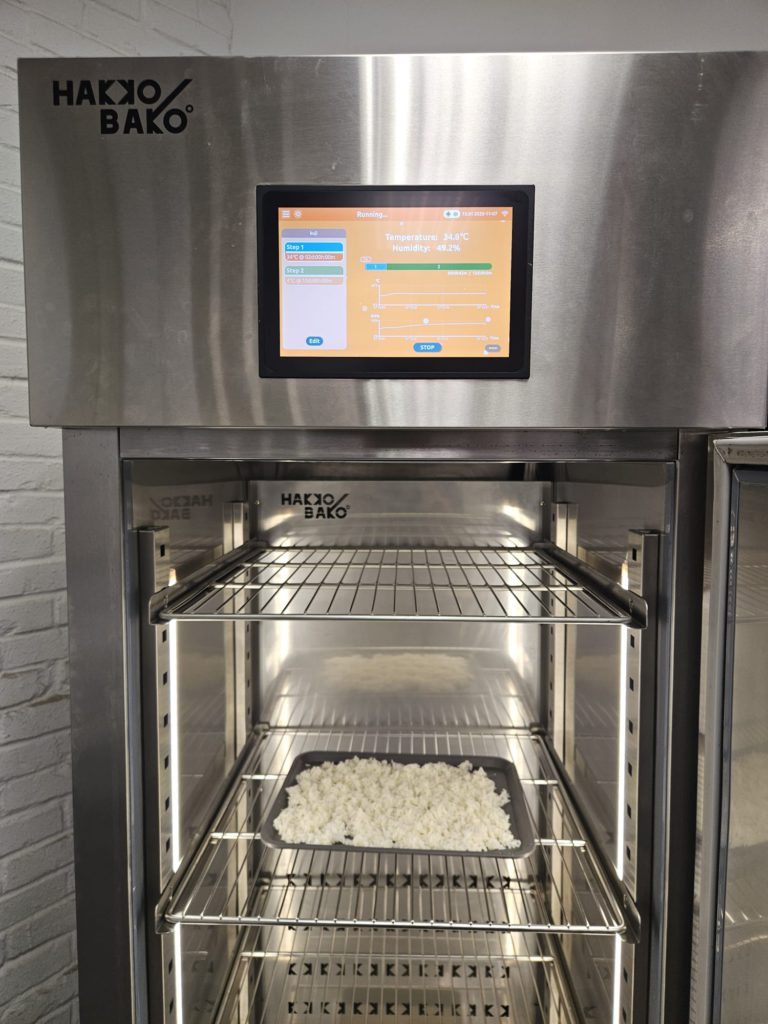Koji (Aspergillus oryzae) is the cornerstone of complex umami flavors, essential for everything from miso and soy sauce to modern garums and shio koji seasoning. While traditional Koji making is an ancient process that depending on the weather, seasons and environment the HakkoBako Pro Fermentation Chamber transforms it into a reliable, high-volume operation.
This post walks through our method for creating rice Koji, leveraging the precision control of the HakkoBako Pro, and demonstrating how you can produce up to 300kg of high-enzyme Koji in a single batch.

Substrate Preparation
The quality of your substrate dictates the quality of your Koji. While many recipes strictly call for steamed rice, our testing has shown that successful Koji production is more about moisture control than cooking method.
We successfully use traditionally cooked rice, provided the water level is carefully controlled to avoid an overly wet substrate. The goal is rice that is firm, yet fully hydrated. It is also possible to ferment the koji on rice flour especially if focus is to make just the starter for later dehydration or freezing.
The Fermentation Protocol: Precision Incubation
The HakkoBako Pro acts as a high-precision incubation chamber.
Step-by-Step Production:
-
Preparation: Spread the prepared rice evenly across plastic trays. A thin, consistent layer is desired.
-
Inoculation: Evenly dust the rice substrate with your A. oryzae spores (Koji starter).
-
Incubation: Place the inoculated trays inside the HakkoBako Pro Chamber. We set the chamber for a 2-day (48-hour) fermentation period at:
-
Temperature: 34°C
-
Humidity (RH): 75+%RH
-
In traditional Koji production, the batch must be physically turned and mixed every few hours to dissipate heat and ensure consistent spore germination.
Because the HakkoBako Pro provides sufficient internal airflow and precise, controlled climate management, the microbial environment remains stable.
We do not touch the Koji for the entire two-day fermentation period. This automation saves immense labor costs and guarantees superior consistency across batches.
Post-Fermentation
The goal of Koji is to generate enzymes (proteases, amylases, etc.). Allowing fermentation to continue past its peak can result in “over-fermenting,” which generates unwanted heat and consumes too much of the substrate, reducing enzyme potential.
Chilling Program: After the 48-hour fermentation cycle, the HakkoBako Pro automatically executes a chill-down program, setting the chamber to 4°C. This rapid drop in temperature effectively slows the microbial activity, preserving the peak enzyme yield and securing the perfect quality for downstream use.
The Cost-Effective Solution
The ability to produce Koji in-house is a massive competitive advantage for kitchens specializing in flavor bases.
-
High Volume, Low Cost: The HakkoBako Pro allows you to ferment up to 300kg of Koji in a single batch.
-
Production Independence: This scale makes it incredibly cost-effective for large-scale operations that rely on these enzymatic ingredients for production (miso, soy sauces, garums, shio koji), eliminating the need to purchase expensive, pre-made starters or bulk Koji.
Want to learn more?
The HakkoBako Pro is the only fermentation chamber that gives you the control and capacity needed to produce Koji at a commercial scale, consistently and profitably. Get in touch with us to learn more!

